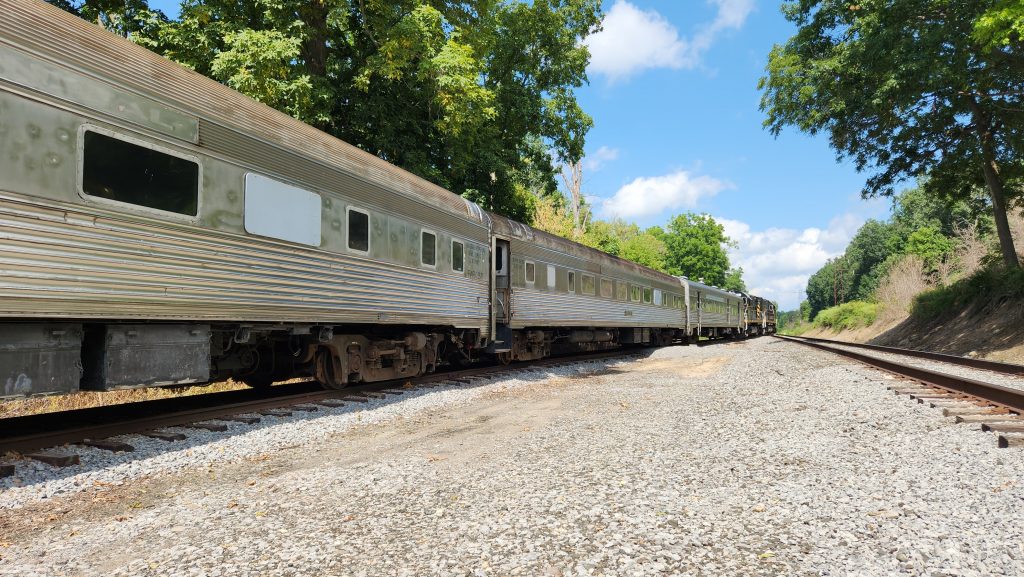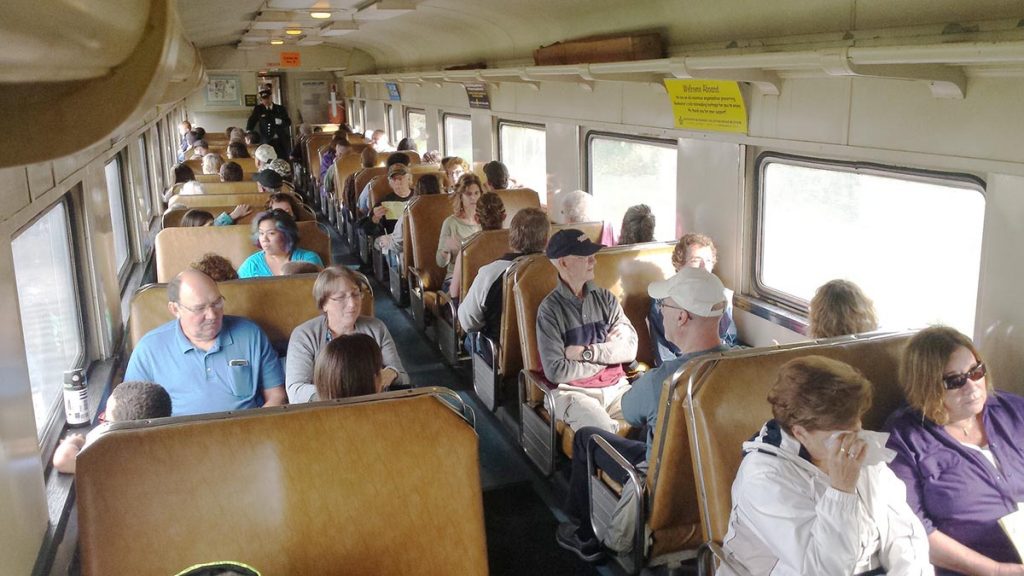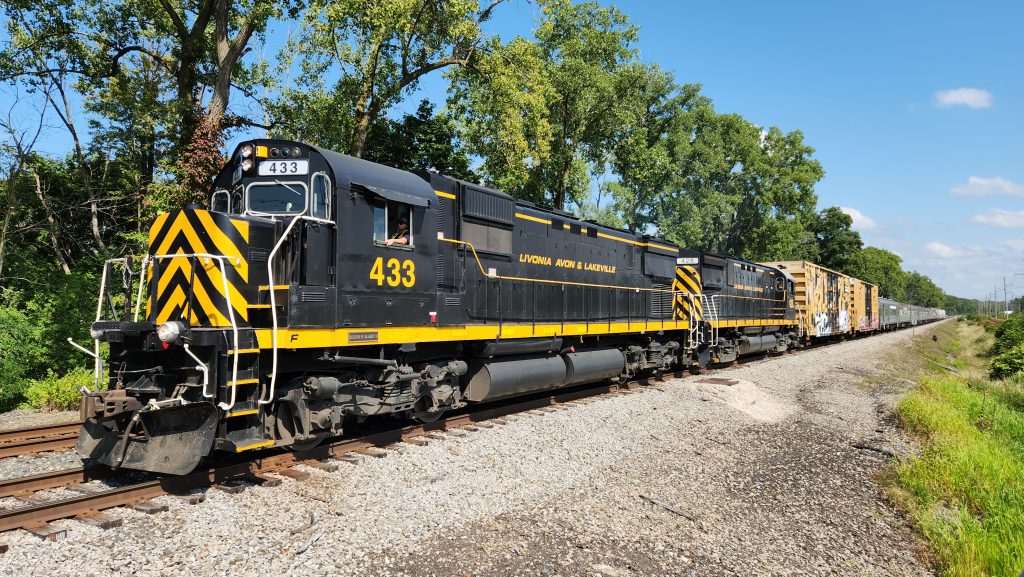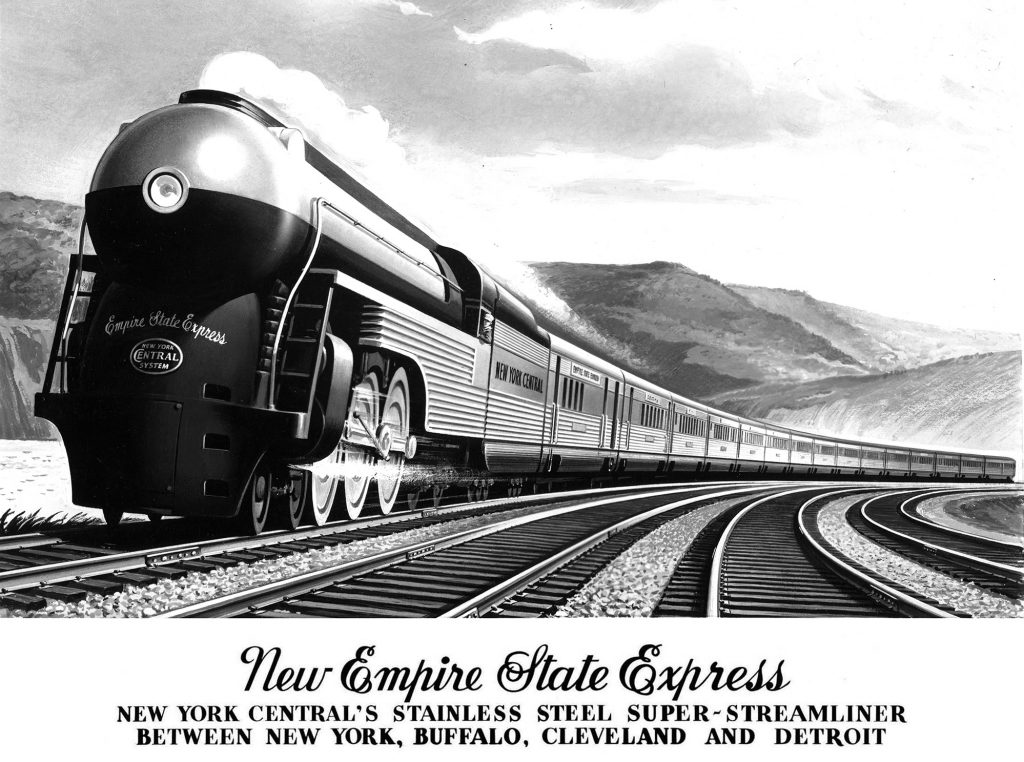ROCHESTER, NEW YORK — As part of an ongoing investment in its new rail tourism program, the Fort Wayne Railroad Historical Society has acquired seven former Empire State Express streamlined passenger cars from the Rochester & Genesee Valley Railroad Museum (RGVRM) in Rochester, New York. Once part of the New York Central Railroad’s famous “Great Steel Fleet” of passenger trains, the collection is now destined to regularly appear behind restored steam and diesel locomotives from the 1940s and 50s.
Built in 1941 for use on the Empire State Express, a flagship first-class passenger train of the New York Central, the cars will operate over former New York Central trackage in Indiana and Michigan. Restoration of the fleet is estimated to cost over 1.2 million dollars, with plans to fund the work through donations, grants, and ongoing ticket sales over the next several ensuing years. The organization’s first goal is to raise $160,000 in order to place one coach in service in 2024. A capital campaign has been launched at greatsteelfleet.org.
“This acquisition will ensure we have a dedicated fleet of our own equipment for both the Indiana Rail Experience and future steam excursions around the country and helps strengthen our business model,” said Joe Knapke, President of the Fort Wayne Railroad. “Rochester’s care and stewardship in preserving this equipment through the years means that the cars will be enjoyed by thousands of people every year.”

ABOVE: The Empire State Express cars departed R&GVRRM on the morning of August 29, destined for their new home at the Fort Wayne Railroad Historical Society. —Otto M. Vondrak photo
The streamlined Empire State Express operated between New York City, Detroit, and Cleveland, and each of the preserved cars debuted in the inaugural run on December 7th, 1941 – only hours before the attack on Pearl Harbor. In later years, they were rebuilt for commuter service. Six cars from the fleet were acquired by the Rochester Chapter of the National Railway Historical Society in 1987 and made part of their growing museum collection where it was later joined by a railway post office car to complete the set. Refurbished by volunteers, the cars were used for a series of seasonal fall foliage excursions operated in the region through the 1990s and early 2000s, with the most recent trip taking place in 2019.
“These cars were state of the art when introduced and are beautiful examples of innovative, stainless steel construction during a period of optimism and investment in passenger rail,” said Otto Vondrak, president of RGVRM. “These lightweight, stainless steel cars set the standard for a generation of the traveling public. The Budd Company built these cars to last and they are destined for a bright future,” detailed Vondrak.
Over the next several years, the cars will undergo modernization of their mechanical, heating, and electric systems and additional work will update restrooms and seating. Two cars are likely candidates for conversion into first-class cars dining or parlor cars inspired by the New York Central’s original designs. The acquisition of the equipment was partially funded by a grant from the David A. Donoho Trust and the Central Indiana Foundation.

ABOVE: Built in 1941 as 56-seat long-distance coaches, and rebuilt as 108-seat commuter coaches in 1966, R&GVRRM refurbished these cars and used them in seasonal excursion service over the years. —Otto M. Vondrak photo
“Not many organizations have the resources to acquire, maintain, and operate a full seven-car passenger train, let alone one single car,” Vondrak said. “After a long career in preservation, RGVRM determined this train to be surplus to the museum’s collection. I’m proud of our museum’s accomplishments in preserving this historic train set, and our members are excited for its future. We can’t wait to see this classic streamliner operate with a powerful steam engine across the farmlands of the Midwest as they first did 82 years ago.”
Since the 1980s, the Fort Wayne Railroad has operated passenger excursions and public exhibition trains with restored Nickel Plate Road steam locomotive no. 765, often leasing privately owned passenger cars in order to accommodate the general public and make excursions financially viable. Since 2022, the organization has purchased two former Pennsylvania Railroad coaches, completed the restoration of a dining car and open-air car, converted a former baggage car into a power car to provide electricity for its trains, and also acquired an unrestored Canadian Pacific dome-observation-lounge car.
“With rising costs, limited availability, and logistical constraints, leasing even the best cars can make or break this business,” detailed Kelly Lynch, Vice President of the Fort Wayne Railroad. “We’ve gone from having no operating cars to a growing fleet in less than two years. As the Empire cars enter service over time, they will greatly expand our train sizes, capacity, and variety of trips, which means donations toward restoring our fleet can double and triple the impact our trains have.”

ABOVE: Livonia, Avon & Lakeville hauled the Empire State Express cars to the interchange at Genesee Junction on August 29, where they will begin their journey west towards Indiana over the former New York Central main line operated by CSX Transportation. —Otto M. Vondrak photo
The Fort Wayne Railroad also recently purchased a former New York Central depot in Pleasant Lake, Indiana to support the Indiana Rail Experience, an ongoing partnership between the non-profit and the Indiana Northeastern Railroad Company, a privately-owned 100-mile short line railroad. Earlier this year, the program was named Indiana’s Best New Experience by the state tourism bureau for its impact on the region.
“In addition to boosting the local economy, we are planting the seeds for an immersive, linear cultural experience, where the passenger cars, stations, and locomotives are all from the same era, if not from the very same historic railroad,” said Lynch. “There are compelling models throughout the world that demonstrate how a tourist railroad can create an enduring sense of place and improve an area’s quality of life, and the Indiana Rail Experience hopes to build on these great examples and our own accomplishments so far.”
Photo Galleries
- Historic photos of The Empire State Express
- 2017 RGV Fall Foliage Express Photos
- 2019 RGV Fall Foliage Express Photos
Technical Data
- NYC 2566 – Built 1941 as 56-seat coach, rebuilt as 108-seat commuter coach in August 1966, became NYC 1703. Named Richard Tickner by museum volunteers to honor a long-time member of Rochester & Genesee Valley Railroad Museum.
- NYC 2567 – Built 1941 as 56-seat coach, rebuilt as 108-seat commuter coach in September 1966, became NYC 1711.
- NYC 2568 – Built 1941 as 56-seat coach, rebuilt as 108-seat commuter coach in December 1966, became NYC 1700.
- NYC 2571/Hamilton Fish – Built 1941 as 56-seat coach, rebuilt as 108-seat commuter coach in October 1966, became NYC 1705. Hamilton Fish was the 16th Governor of New York (1849-1850).
- NYC 2572/David B. Hill – Built 1941 as 56-seat coach, rebuilt as 108-seat commuter coach in October 1966, became NYC 1707. David B. Hill was the 29th Governor of New York (1885-1891).
- NYC 2578/Charles Whitman – Built 1941 as 56-seat coach, rebuilt as 108-seat commuter coach in November 1966, became NYC 1701. Charles S. Whitman was the 41st Governor of New York (1915-1918).
- NYC 5021/Alonzo B. Cornell – Built 1941 as Railway Post Office, to Penn Central in 1968 (renumbered 6500), sold to James E. Strates Shows, National Research Council in 1971 (renumbered 1001), purchased in 1991 by Empire State Railcar, sold to RGVRRM in 1993. Alonzo B. Cornell was the 27th Governor of New York (1880-1882).


